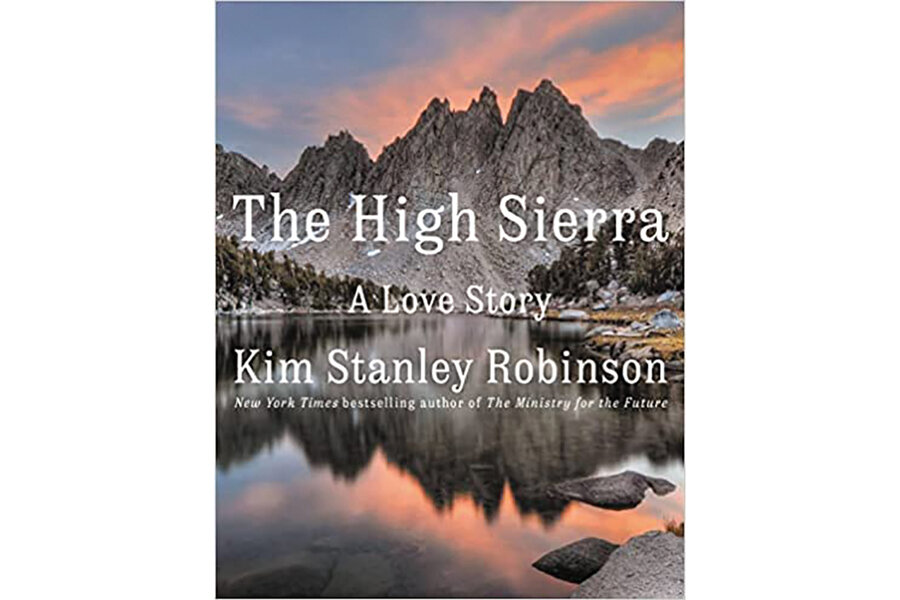Science fiction author draws inspiration from the Sierra
Loading...
It took only a single visit for Kim Stanley Robinson to fall in love with the Sierra Nevada in northeast California. Maybe it was simply the right time – the summer of 1973, during the future science fiction writer’s college years. Perhaps it was the company – a close-knit group of California athletes-adventurers-hippies. Whatever the confluence, Robinson calls that initial trip “[a] four-day conversion experience, a road-to-Damascus event. Now I was a Sierra person.”
Robinson returned from the trip a changed man, one who would go to the Sierra more than 100 times, becoming uniquely qualified to write a comprehensive guide to “the best mountain range on Earth, if backpacking is the game you want to play.” ”The High Sierra: A Love Story” gives Robinson the room to write at great length about a wilderness he cherishes, and he brings an idiosyncratic perspective in describing its wonders, large and small, in this unique memoir and guidebook.
Equally adept at writing about the distant past, the near future, and locales as far apart as Alpha Centauri and Orange County, Robinson is one of the most environmentally astute science fiction writers of his generation, having written more than 20 books, including “New York 2140,” a portrait of the metropolis as it succumbs to rising sea levels, and “Aurora,” which explores the limits of interstellar travel. Whether writing fiction or nonfiction, he gets the details right.
Robinson acknowledges the ways in which the Sierra has influenced his fiction, starting with his “Three Californias” trilogy and the novel “The Gold Coast” which Robinson regards as his “take on the seventies from the perspective of the eighties.” Later on, snow camping gave him insights about survival that would prepare him for writing “Shaman,” about our cross-continental traveling ancestors.
But perhaps the books most aligned with his Sierra experience would be “The Mars Trilogy,” his best-known and most popular works of fiction.
He writes, “Indeed, the process of terraforming Mars, as described in my novel, was really a matter of turning the Red Planet into something more like the high Sierra.” Is it right to say the Sierras have always played an important role in his fiction? “How could they not?” he says.
“The High Sierra” brims with useful information, containing maps, photos, and nature poems as well as practical advice on what to pack, where to hike and how to stay alive and comfortable through the night. With an annotated bibliography providing a generous selection of further resources, the book invites both intense study and casual browsing.
Chapters of particular note are those tagged “Moments of Being” and “My Sierra Life.” Robinson writes insightfully about his own thoughts and motivations, and captures the changes that came to hiking friendships over years. His thumbnail sketches of other “Sierra People” are concise and well-crafted. Robinson’s choices include physician and science fiction writer Michael Blumlein, conservationist John Muir, memoirist Mary Austin, and poet Gary Snyder.
Robinson also recognizes the indigenous people who have lived in the Sierra across 10,000 years of human habitation. He argues for returning to native names in the area, even while promoting place names honoring his own favorites, including Henry David Thoreau and Ursula K. Le Guin.
He recounts being inspired to label an unnamed peak near one already named for poet Ralph Waldo Emerson, writing “the two peaks had much the same relationship as Emerson and Thoreau, not just in size and aspect but in position, being close to each other but separated by a huge gulf of air. It was like that in Concord,” Massachusetts, where the two men lived.
Robinson is able to spot what distinguishes an item – a geological specimen, a fellow traveler on the trail, a marmot sunning itself – and convey how it fits into the grander scheme of life in the Sierra. He communicates his observations without any kind of overblown mysticism, but with a deep sense of gratitude, an appropriate sense of wonder, and a welcome sense of humor.
Sometimes it feels as if the density of “The High Sierra” might be too much of a good thing, as Robinson describes routes he took while backpacking on barely memorable trails. But then there are some truly harrowing maneuvers. When hair-raising events occur, the author describes the action lucidly and grippingly.
Robinson discusses the environmental impact of climate change in the Sierra. He foresees higher temperatures, longer droughts, disappearing glaciers, and perhaps the northern extension of Arizona’s midsummer monsoon, which might help relieve the droughts. “May they hit hard every summer! We can deal.”
“The High Sierra” makes good on the promise of its subtitle. On every page, Robinson celebrates the mountain range, conveying in his intimate and distinctive fashion his abiding love of the place. Anyone who opens their heart to the mountains – veteran trekker, casual explorer, or complete neophyte – will be well rewarded by this singular book.











